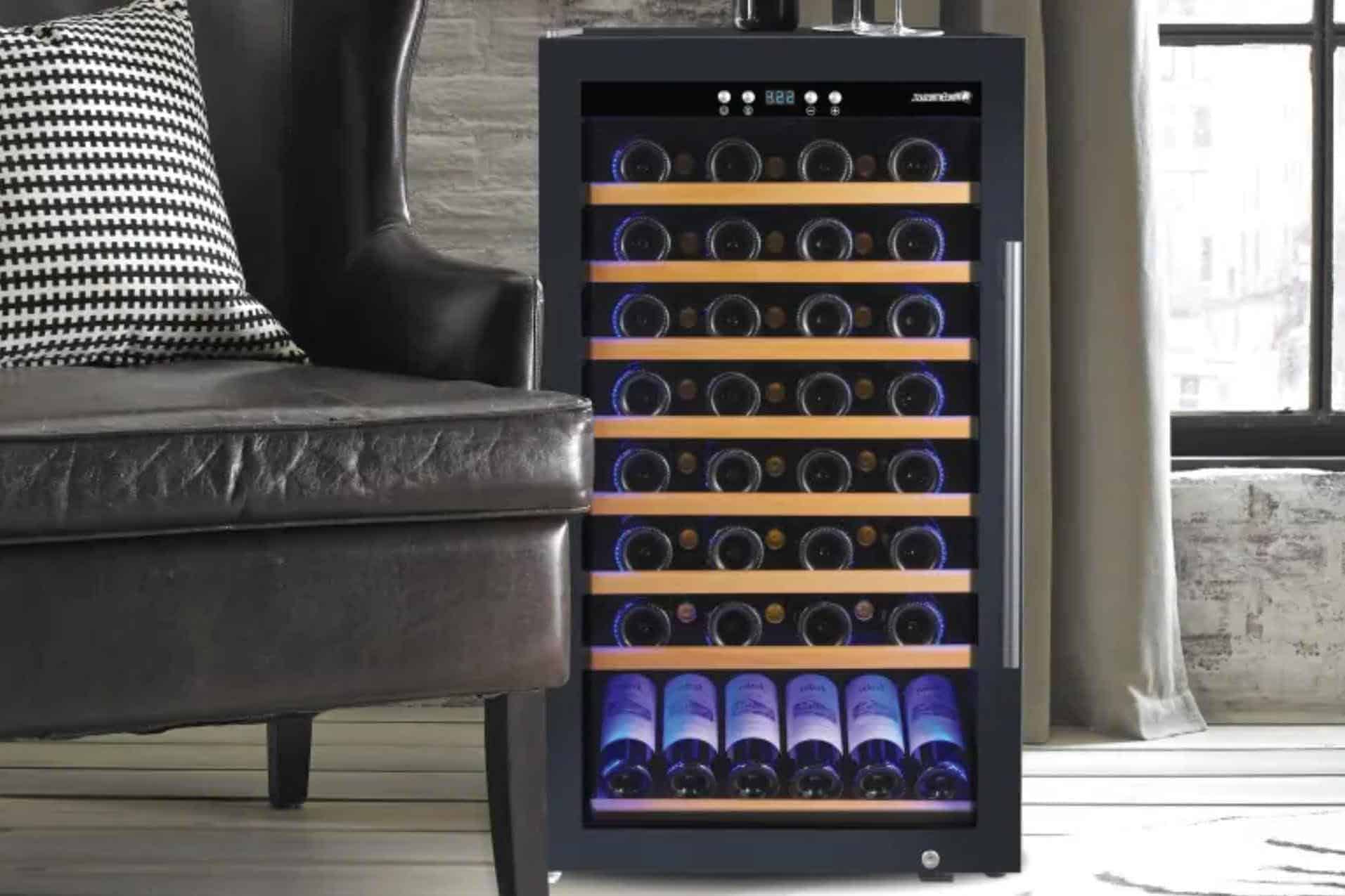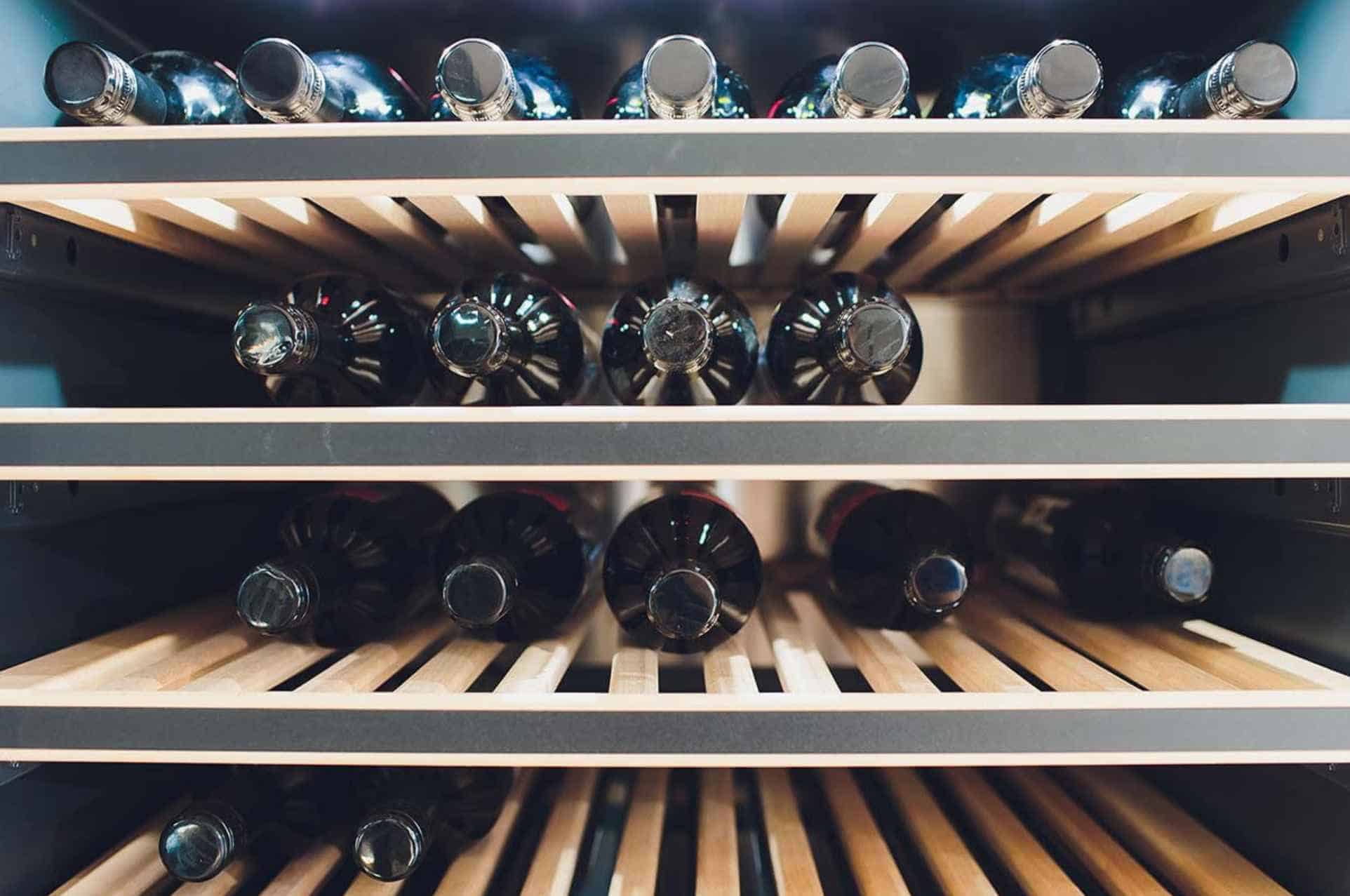Wine requires unique refrigeration storage methods to retain its delicious flavor and aroma. It’s best to follow the optimal temperature for each bottle so you can serve it perfectly every time.
Perhaps you’re asking yourself, at what temperature should a wine fridge be? Read on to learn more about the various temps for different wine varietals.
What is the Ideal Fridge Temperature for Red Wines?
Suppose you’re a fan of the sensory experience brought by luscious red wine. Perhaps, you’re serving steak or barbecue for a party, and you’re pairing it with Merlot or Cabernet Sauvignon.
The following fridge temperature guide can help you store you’re precious reds to preserve their flavor and tannin texture.
Full-Bodied Red Wines
Recommended Fridge Temp: 66 to 67 degrees Fahrenheit
Exceptionally rich, full-bodied red wines such as Red Zinfandel, Syrah, or Bordeaux thrive at 66 to 67 degrees Fahrenheit. Burgundy and Cabernet Sauvignon would also benefit from this optimal temperature.
You will notice that the temp setting is warmer than in other wine categories. This temperature allows the palate to enjoy these wines’ lush mouth-feel and complex texture.
Medium-Bodied Red Wines
Recommended Fridge Temp: 60 to 62 degrees Fahrenheit
Red wines from this category will benefit from a slightly lower temperature than their full-bodied family. You can enjoy the increased fruitiness and acidity from a somewhat chilled bottle. Set the fridge to 60 to 62 degrees Fahrenheit if you’re storing bottles of Malbec, Merlot, Rioja, and Grenache.
Light-bodied Wines
Recommended Fridge Temp: 55 to 60 degrees Fahrenheit
Light-bodied wines have a thinner and lighter feeling in the mouth, making them ideal for food pairing. Wine connoisseurs recommend them for summer drinking.
Unlike the wines from the two earlier categories, light-bodied wines are best when cold and not at room temperature. When you’re serving Chianti, Barbera, Beaujolais, and Pinot Noir, it’s best to cool them first at 55 to 60 degrees Fahrenheit.
Rosé wines can also benefit from this temperature setting. This type of wine has a pinkish color and a lighter texture than red wine. It undergoes the same process as red wines but with shortened fermentation time.
An Overview of Red Wines and their Ideal Fridge Temperature
| Type | Examples | Temperature |
| Full-Bodied | ● Red Zinfandel
● Syrah ● Bordeaux ● Cabernet Sauvignon ● Burgundy |
66 to 67 degrees Fahrenheit |
| Medium-bodied | ● Malbec
● Rioja ● Merlot ● Grenache |
60-62 degrees Fahrenheit |
| Light -Bodied
|
● Chianti
● Barbera ● Beaujolais ● Pinot Noir |
55-60 degrees Fahrenheit |
| Rosé | ● Sangiovese Rosé
● Grenache Rosé ● Syrah Rosé |
55-60 degrees Fahrenheit |
What’s the Ideal Fridge Temperature for White and Sparkling Wines?
Many people enjoy the lightness and freshness of white wine. If you’re serving light seafood, creamy dishes, and lemon-based meals, stock up on white wines. The following guide will help you store them in the fridge to achieve the best flavors.
Full-bodied White Wines
Recommended Fridge Temp: 52-55 degrees Fahrenheit
Creamy and luscious white wines are best stored and served a bit warm. However, they’d best served colder than the full-bodied red wines mentioned earlier.
Suppose you’re planning on pouring Viognier, Chardonnay, Sauternes, or Montrachet. It’s best to ensure they’re stored at 52-55 degrees Fahrenheit to maximize their flavors and aromas.
Medium-bodied White Wines
Recommended Fridge Temperature: 50 degrees Fahrenheit
Dry or sweet white wines under this category contain less alcohol than their full-bodied relatives. The flavor and aroma won’t lose appeal even if they’re chilled at a lower temperature.
Riesling and Chablis will shine best if they’re refrigerated at 50 degrees Fahrenheit. However, if your Riesling is on the sweeter side, you must store it at 40-45 degrees Fahrenheit. You’ll notice that a slightly colder sweet Riesling will not have a syrupy texture.
Light-Bodied White Wines
Recommended Fridge Temperature: 46-48 degrees Fahrenheit
These exceptionally refreshing and light white wines shine best when cold. The lower temperature brings out the bright flavors and crispness, making them enjoyable.
You can drink them on your own or pair them with seafood or salad. Sauvignon Blanc and Pinot Noir are best stored at 46-48 degrees for optimal drinking pleasure.
Sparkling and Dessert Wines
Recommended Fridge Temperature: 40-45 degrees Fahrenheit
If you’re celebrating with a bottle of bubbly, it’s best to chill them first. Carbonated drinks such as sparkling wines showcase their crispness and refreshing qualities when they’re cold. You’ll get maximum enjoyment from Prosecco, Champagne, Cava, and Asti when they’re cold.
Summary of White and Sparkling Wines and their Ideal Fridge Temperature
[wptb id=2940]
What is the Wine Fridge Temperature Range?
The standard units available in the market have temperature settings between 40 to 67 degrees Fahrenheit. Some units can go below 40 degrees, but this temperature is not ideal for wines.
What is a single-zone wine fridge?
A single-zone wine fridge is a type of wine storage that allows only one temperature setting. It’s usually more economical and easier to use, especially for beginner wine collectors. However, it can prevent you from having a wide range of options.
What is a dual zone wine fridge?
If you plan to add more variety to your wine collection, choose a dual zone wine fridge. This type of wine storage allows two temperature settings in one appliance. There are two compartments in a dual-zone wine fridge.
You can set one area at a warmer temperature, usually the lower part. Meanwhile, the upper zone can accommodate wines requiring colder temperatures.
Why is it important to follow the right fridge temperature?
Understanding and maintaining the right wine fridge temperature may seem daunting. However, it is crucial for the following reasons:
- Storing wines more than the required temperature may result in aroma and flavor loss.
- When you refrigerate wine in a fridge with extremely low temperatures, ice particles may form inside the bottle. It will force the wine out of the cork.
- If there is a constant fluctuation of temperature, the cork will expand or contract. It will cause oxygen to seep through. When it happens, the wine will age prematurely.
- The right temperature allows proper wine preservation. It can also help the development of aromas, flavors, acidity, and structure. These complex processes enable the wine to age gracefully.
- Following the temperature guidelines will allow you to maximize the wine’s flavors, tannins, and aroma. It will make your drinking and dining experience more enjoyable.
- Keeping wines at the optimal temperature is a way of honoring the wine’s journey. Every wine goes through a complex and delicate process, from the vine to the bottle. It will be a waste if you’re unable to taste the best the wine offers.
What are the tips on storing wine in the fridge?
The following tips will help you get the most out of your wine fridge storage.
- Consider where you will place your wine fridge. It’s best to avoid patios, outdoor kitchens, and non-air conditioned garages, especially during hot weather. Harsh environments such as these will force your unit to work harder than it’s supposed to. An overworked motor can lead to a shortened lifespan.
- Electrical fluctuations may stress the wine fridge unnecessarily. If possible, place them in areas where you’re sure that the current is stable. Although most units can withstand fluctuations, it’s still best to be safe. You may install a surge protector to prolong your refrigerator’s life.
- Ensure that you follow the manufacturer’s maximum wine capacity recommendations. When you overfill the fridge, it might not be able to provide the optimal temperature.
- Don’t worry if you can’t fill the fridge yet. It will still work perfectly fine. Take your time building your collection. The important thing is that you already have storage and know how to refrigerate your wines.
- Store the wines horizontally inside the fridge. This position will keep the corks moist and prevent oxygen from seeping.
- Use the deck portion of the wine fridge to store the wines you plan to drink. Please place it in that area 24 hours before serving. Doing so will allow you to achieve the right drinking temperature.
- Once you’ve set the fridge to the ideal temperature, maintain it. Constant changes in temp can degrade your wine’s quality. These fluctuations can cause your wine to contract or expand. These chemical reactions can cause the cork to dry out or crack. When these damages happen, oxygen can seep through and affect your wine’s flavor and aroma.
- Avoid transferring the wine cooler when there are wine bottles inside. Vibrations and movement can negatively affect the wine’s quality. Additionally, do not place them in a busy area where you might need to move them often.
- Avoid storing food or drinks with a strong odor inside your wine fridge. Doing so might affect your wine as well. Use your wine fridge as a dedicated space for your precious wines.
Chill and Cheers
Suppose you’re planning on expanding your wine collection. Finding the best refrigeration unit is best. You must address one concern: what temperature should a wine fridge be? Knowing the best fridge temperature setting for various wine varietals will allow you to enjoy every sip.

George Moore, co-founder of Wine Flavor Guru, is a charismatic entrepreneur with a rich background in California’s wine industry. Alongside Sylvia, he transformed a Sonoma County vineyard into a source of premium wines. George’s expertise in sourcing exceptional grapes and his approachable style make wine appreciation both accessible and engaging.









